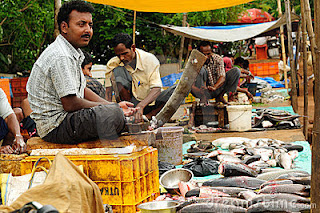Pandiarajan or Pandi as most people know him is a 31 year old fish-seller in one of the suburban fish-markets of Chennai (he receives a monthly salary and runs the shop on behalf of the owner). He has been the bread-winner of his family from the age of 14 when his father deserted the family owing to his problems with drugs and alcohol. Pandi is the eldest of 4 kids – 2 boys and 2 girls. His job as a fish-seller is the 3rd job in his life and he has previously worked as a computer technician, an assistant in a vegetable market and then as a salesperson in a famous retail outlet in T Nagar. Having worked in the fish market for 14 years, he opened his first savings account only 5 years ago.
- “They are very document as well as procedure oriented”
- “Any transaction with respect to a bank is time-consuming and time is a huge asset for me who relies on daily transactions to make a living”
- “They did not grant me a loan for a vehicle which I wanted to use to generate an alternate income. Their reason being I did not have any form of collateral”
- “I have to spend a lot of time in cleaning myself and making myself presentable so that people at the bank do not complain about any smell. Despite this, they do not treat me with any form of respect. There is some amount of social stigma against fish-selling people”
- “I know the bank is meant to help people and I respect their service. However, I feel they are more interested in serving high-income clients/rich people”
- “The best thing about banks in recent years is the introduction of the ATM machine as it reduces the chance to meet bank staff to some extent”
- 4 Lakh – his own money (bank deposit)
- 5 Lakh – brother-in-law has loaned him
- 8 Lakh – multiple loans and all of the 100-day repayment period [as on date, Pandi has paid 5 Lakh already]
- 7 Lakh – gold purchases + sold his 2nd car bought in 2010
- Is Pandi’s story an exception among the poor? Can it be replicated?
- Pandi did not receive any formal financial literacy, yet he saved, albeit informal sources
- Has the formal financial institution really understood the customer?
- Is social stigma and other factors preventing formal institutions from tapping the potential of many clients
- Can formal and informal savings mechanisms co-exist? Should they?
We may not be able to find a quick and immediate answer to many of these questions. Enabling and enhancing the livelihoods of the poor (rural and urban) is not just a financial cause, I believe it must be looked upon as a social mission. Perhaps, the thought alone may lead to more innovative financial products.






